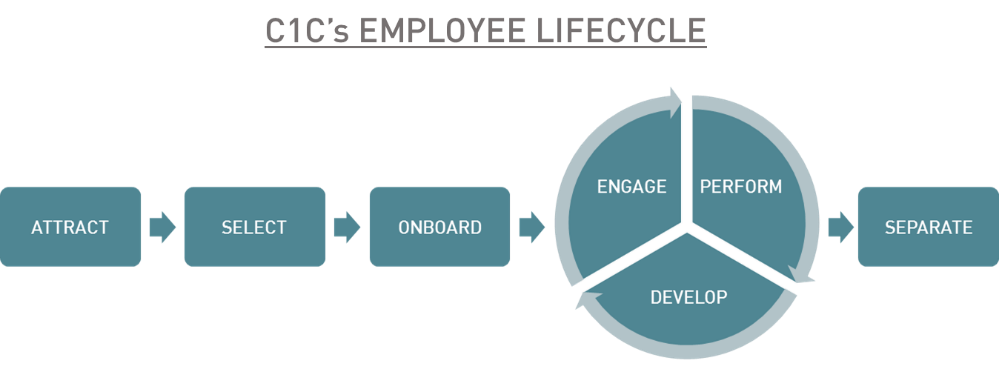Are People Your Organization's Greatest Asset? Then Read This
“People are our greatest asset.”
At C1C, we believe that employees can be an organization’s greatest asset when scientifically proven methods are used across the employee lifecycle.
It seems we have heard CEOs and organizational leaders say this countless times. These individuals proclaim that their organization would not be successful without its talented workforce. Despite this apparent belief, many organizations do not fully optimize this asset. They often fail to develop practices that help their employees perform well, be engaged, and want to stay at the company. At C1C, we believe that employees can be an organization’s greatest asset when scientifically proven methods are used across the employee lifecycle.
Below, I will walk through each stage of our approach to the employee lifecycle (see Figure) and provide a few examples of how you can optimize your greatest asset at each step using scientifically proven employee practices.
Attract. The first step in our employee lifecycle is attracting great, high-performing applicants to your organization. One way organizations can attract great employees is by understanding and optimizing their employee value proposition (EVP). An EVP refers to the set of attributes an employee gets in exchange for working at an organization. This includes both tangible attributes like compensation and benefits and intangible attributes like developmental opportunities and the organization’s reputation. Strong, well balanced EVPs make great employees want to work at your organization. You can also attract employees to specific jobs in your organization with clear and informative job descriptions. Well-written job descriptions provide the job’s duties and requirements to help potential employees decide if they have the skills needed for the job and if the job is a good fit for them.
Select. Next, organizations must select the right employee for the job and the organization. Although all stages in the employee lifecycle are important, we believe that selection is arguably the most important in terms of the impact it will have on your organization. If the best candidates are hired in the first place, they will require less time and resources for training, developing, and engaging them. Although there are many great options for valid, evidence-based selection tools, most organizations continue to use methods that are no better than chance at predicting which candidates will do best on the job (e.g., unstructured interviews). To select the best talent, we recommend starting with evidence-based interviews, as interviews are already a step in most organizations’ hiring process. See my past posts for an overview on why evidence-based interviewing is so important and for a guide on how you can conduct them in your organization.
Onboard. Next, new employees must be onboarded to the organization. Onboarding is the process of helping new employees acquire the knowledge, skills, and behaviors needed to become contributing organizational members. Onboarding has three major components. First, during onboarding an employee should be introduced and integrated into the organization. This includes learning about the company’s mission and vision, culture, and organizational practices. Second, an employee should be socialized and integrated with their team. Here, specific steps should be taken to ensure new employees are getting to know their fellow team members, what their roles are, and their areas of expertise. Finally, onboarding should train new employees to do their jobs. This could include methods such as formal training programs, on-the-job trainings, and job shadowing. The goal of this training during the onboarding stage is to provide new employees with the information and skills they need to be productive, contributing team members in relatively short amount of time. Once employees have been onboarded, they enter an ongoing cycle of engagement, performance, and development. These three stages tend to be highly interconnected, meaning that when efforts are made to improve one area, the other two areas will improve as well.
Engage. There are varying definitions of what employee engagement includes. However, most believe that it includes both an employee’s commitment to the organization and motivation to contribute to organizational success. At C1C we believe engagement is defined by several key factors including an employee’s desire to stay with the company, their discretionary effort, and their pride in the company. Regardless of how engagement is specifically defined, research shows that more engaged employees are higher performers and are less likely to leave the organization. To track and improve employee engagement, it is essential that it be measured, typically through an employee survey.
Perform. Engaging and developing employees means little if they are not providing the levels of performance needed by your organization. Two ways organizations and managers can specifically improve employee performance is through feedback and measurement. By providing feedback on how employees have performed in the past, managers can help shape and improve employee’s performance for the future. Additionally, measuring performance provides employees with formal feedback on how they are performing in their role and holds them accountable for performing up to expectations.
Develop. Even when employees are selected and onboarded well, they often need and desire additional development to optimize their performance in their current job and to prepare them for their next opportunity in the organization. Having developmental opportunities is important to many employees; they want the opportunity to better themselves and improve their performance at work. Employee development can be accomplished in many ways, from formal training programs to “stretch assignments.” In formal training programs, employees receive instruction to improve their knowledge and skills. Stretch assignments allow employees to learn and develop by taking on responsibilities that are outside of their current role and past experiences. Developing employees is important to employee and organizational growth.
Separate. The final stage of the employee lifecycle is separation, when an employee leaves the organization. Although the employee is exiting the organization, this stage should be treated as an opportunity to learn about why. Through data collection methods such as in-person exit interviews and/or confidential exit surveys, organizations can better understand why employees are leaving the organization, determine whether areas for opportunity exist, and then act upon those opportunities to retain their current talent.
Many organizations hold that their people are their most important asset, however, many fail to fully optimize that asset. We believe this should be done at each stage of the employee lifecycle using scientifically proven methods. If you have questions or would like help developing your organization’s employee lifecycle. Feel free to reach out!


